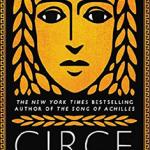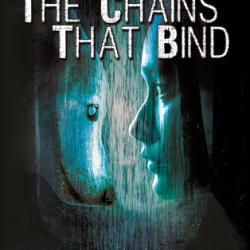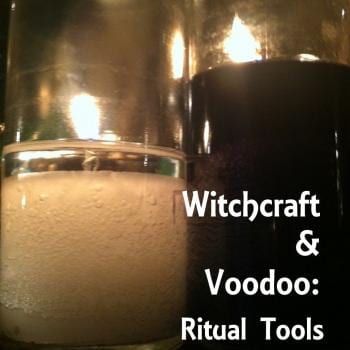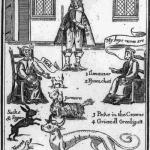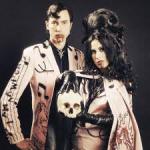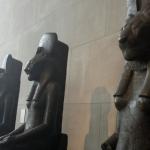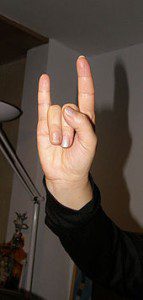
The Satanic Panic of the 1990s was a time of fear and persecution for witches. You want to talk about the Burning Times? We lived it in a social way. Our neighbours would find out we were witches and call the police to say we were sacrificing babies in the backyard; we would be fired from our jobs on vague pretexts; our children would be seized by social services who claimed we were subjecting them to horrible things. A desperate self-protection movement began. Witchcraft is a harmless earth religion, we said. Witchcraft doesn’t believe in the devil; we have nothing to do with him.
But that’s not entirely true.
It can be argued that there was a book that really started modern Wicca, as occult practitioners began to “rediscover” the “ancient pre-Christian religion of witchcraft,” and that was The Witch-Cult in Western Europe by Margaret Murray. In her thesis, Murray proposes that the witch-trials of the Inquisition (and other similar movements of death and persecution) were an organized effort to stamp out the witches who worshipped the Horned God. But they didn’t call him the Horned God; they called him the Devil. They also used that term for the man we would recognize as the High Priest of a coven and it was claimed that he wore the devil’s horns, from which we get the Horned Crown of the High Priest. Though it has also been claimed that the Devil never had horns until the bad press against the Horned God began.
Scholars currently regard the witch-cult theory as discredited; but the early Wiccans believed it, and thus, they unintentionally created a religion that they genuinely believed they were rediscovering from revealed texts and anthropology. Other books began to add to the milieu; among them Charles Leland’s Aradia: Gospel of the Witches. In the creation story of the strega, Aradia is the daughter of Diana and Lucifer, the moon and the sun, sent to the world to teach witchcraft to the masses, poison the oppressors, and liberate the oppressed.

Let me repeat this: the Horned God was called the Devil; and the Goddess was the daughter of Lucifer.
Does that freak you out a little? Hang on, I’m not finished yet.
In the Lesser Key of Solomon, a famous ritual magick grimoire, magickal seals are given to bind and control demons. Among them are listed Baal and Astaroth. Some of you are now asking, “But those are gods, aren’t they?” Well, actually, yes. Baal was a name given to any god that represented competition to the God of the Ancient Hebrews, and Asteroth is a God-dess, to be more precise. So, you ask, how is it that they are listed among the demons? I guess that would be because what is a “demon” sometimes depends greatly on your point of view. To those of Abrahamic faiths, sometimes everything that is not of their God is evil and wrong and their only purpose is to lead you away from the “true path”. So from their perspective, when they describe us as demon-worshippers . . . they’re right.
The humanism movement of the Renaissance caused people to start questioning the laws and ethics of the Church. Perhaps being fully human, and accepting and embracing the human experience and the nature of the human animal rather than trying to repress it, was the path to enlightenment and a good and ethical life. Especially in France, over the next two hundred years, the celebration of the Black Mass became not a ceremony to worship the Devil, but a ceremony to renounce and challenge the Church. This must have been terrifying and exhilarating to the people of the time. Lucifer – whose name, after all, means “Lightbringer,” and whose association is Venus, the Morning Star (so yes, there’s a connection to Astarte, and Ishtar, and Inanna) – came to be seen as a Promethean figure. His refusal to bow to the will of a “tyrannical God” was not unlike that of Lilith’s defiance, and history’s telling made Her into a demon too. The Black Mass made its way into French occult practice, and that influenced the Western occult tradition and traditional witchcraft; which of course, in turn, influenced us.
It was John Milton who gave the Devil his horns and his cloven feet; he envisioned this in his classic Paradise Lost. Milton was a polemicist, which is a kind of humanist anti-humanist. To him, the Devil represented the wild side of human nature, the stuff we can’t control. We don’t really know if Milton intended for the Devil to be a sympathetic character, unjustly punished; or if he was intended to be a tragic figure whose own flaws condemned him to his fate, and debate about that continues up to the present. We do know that Milton was generally regarded as a troublemaker with heretical ideas during the reign of Charles I, but he was a successful pamphleteer and publicist under Cromwell.

Eliphas Levi believed Baphomet, which may have had roots in the symbolism of the Templars (who have been linked to the origins of Freemasonry, which is generally accepted to have contributed to the development of modern Wicca in turn,) was a depiction of an occult Kaballistic understanding of the Absolute. He called Baphomet the “Sabbat goat,” and he believed the to be a representation of a Pagan Horned God (as indeed most modern witches believe him to be.) Levi was also a proponent of the supposed “devil worship” of the Witches’ Sabbath being a perpetuation of ancient Pagan rites, and Levi’s image is derived from early depictions of the Devil in the Tarot. He also linked Baphomet to the Goat of Mendez (a Horned God of the ancient Pagan world who represented fertility and reportedly copulated with a woman in a fertility ceremony as witnessed by Herodotus; who was equated with Pan in the writings of E.A. Wallis Budge ). Baphomet later became an important figure in the cosmology of Thelema; and Thelema had undeniable influences upon both modern Wicca and modern Satanism. Indeed, the Sigil of Baphomet is the official symbol of the modern Church of Satan.
Ironically, in direct contradiction to the reduction of Nature to mere scientific inquiry that was begun by the humanist movement, the Romantic , Naturalist and Pastoral movements were born; and from this soup came a variety of faiths, including modern Satanism and Neopaganism. Out of Naturalism came a variety of Hellfire Clubs in England, and they were the elite fraternities of famous aristocracy and writers. Essentially they were carrying on the work of the Black Mass, in which it became fashionable to denounce the Church by tempting the Devil in acts that would be considered blasphemous; or at least, socially risque.
At the same time the pastoral movement encouraged people to look back “to a simpler time” and embrace what they (patronizingly) saw as the “noble savage.” They wanted what they saw as simple, natural pastoral values. Now Pan became the symbol of all the natural joy they felt had been lost to the age of industry.
In English literature of the Romantic period, Pan was often given as another name for Satan. Why the connection, you may ask? Because in Abrahamic faiths, the things that Pan (and Lucifer) represent are dangerous, and they must be repressed or controlled. Pan is a symbol of chaos; He and His much-maligned brother are about lust, pride, power, self-focus and passion.
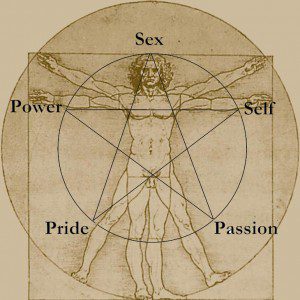
Hey, wait a minute . . . I think I just described the five points of the Iron Pentacle. And speaking of pentacles, I am sure that it did not escape your notice that the Sigil of Baphomet is made up of an upside-down pentacle, representing the four elements of the material world over the fifth element of Spirit; and this is also the symbol of the Second Degree of Wiccan initiation, which is about feces coagulation and coming to terms with your Shadow.
Now I’m not saying there’s anything wrong with Christians (or other Abrahamic faiths) because that’s how they choose to deal with these things. The truth is that they are right; all of this is dangerous stuff. Embrace those principles too completely and you get into deep trouble and cause a lot of harm. Feri and Reclaiming Witches will tell you that the danger of the Iron Pentacle is that it can become the Gilded Pentacle or the Rusted Pentacle instead.
But repression is not the way of Paganism. Generally, Pagans and witches are spiritual humanists. The Horned God of the Witches embodies all of these things, and we believe in embracing these qualities, accepting them and working through them, and then learning to use them in constructive, instead of destructive ways. We do the Shadow-Work. We accept that we have a dark side, and we work with our . . . demons. Denying the Devil is not only denying our true history; it is denying part of our nature. I just don’t think that’s the witch’s way.
One modern theory claims that the practice of the Witches’ Sabbath was actually the underground survival of a shamanic tradition, and therefore, Hell was the Underworld to them. Gardner himself was eager to divorce the Wiccan faith from the very idea of the Black Mass and devil-worship. I think this was an attempt to replace the negative rejection of the Black Mass with something that embraced its principles in a more positive way. To Christian England of the 40s, the Devil was the embodiment of horror and evil; not the wild rebellious God of society’s outlands, and the world was not ready to listen to anyone who said otherwise. But do take note that the Witch’s Rune calls our Goddess not only the “Queen of Heaven,” but also the “Queen of Hell.”
I guess my thesis is not dissimilar from that of Aleister Crowley, when he wrote in Magick (Book 4):
The Devil does not exist. It is a false name invented by the Black Brothers to imply a Unity in their ignorant muddle of dispersions. A devil who had unity would be a God… ‘The Devil’ is, historically, the God of any people that one personally dislikes… This serpent, SATAN, is not the enemy of Man, but He who made Gods of our race, knowing Good and Evil; He bade ‘Know Thyself!’ and taught Initiation. He is ‘The Devil’ of the Book of Thoth, and His emblem is BAPHOMET, the Androgyne who is the hieroglyph of arcane perfection… He is therefore Life, and Love. But moreover his letter is ayin, the Eye, so that he is Light; and his Zodiacal image is Capricornus, that leaping goat whose attribute is Liberty.”
So, my fellow and sister witches, before you denounce those of the left-hand path so quickly, you might want to take a look at your own history and the roots of your spirituality. We don’t believe in Satan, but we do believe in the Devil; only that doesn’t mean what you might think it means.
I was inspired to write this in support of Nornoriel Lokason, who writes the Ride the Spiral blog here on Patheos. Nornoriel works with demons in his practice. He’s pretty direct about this. And he gets a lot of flak for it. Well, my witchy friends . . . denial is not a river in Egypt. Just sayin’. 😉








